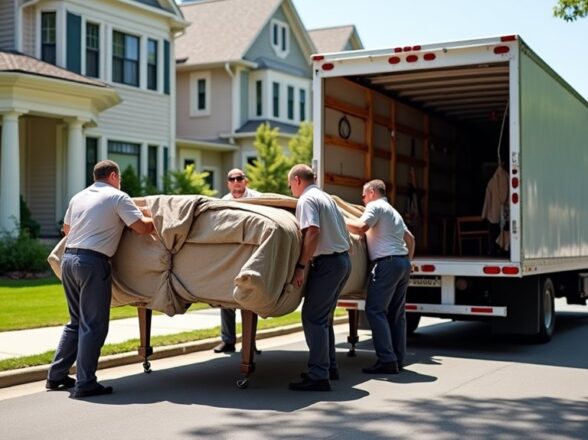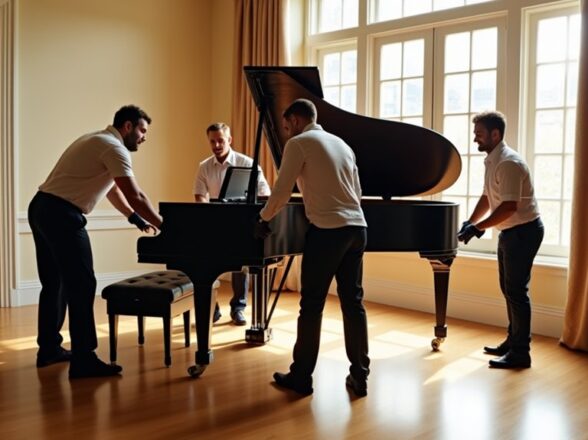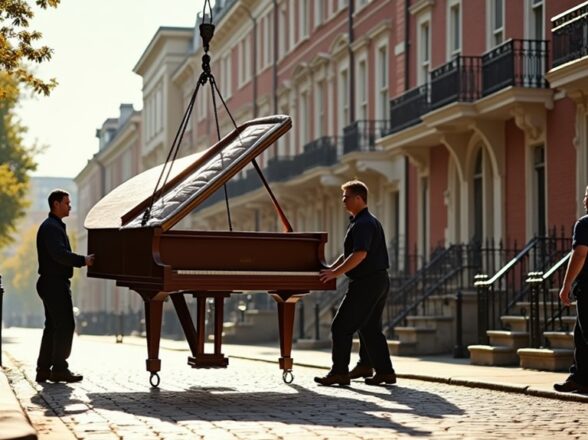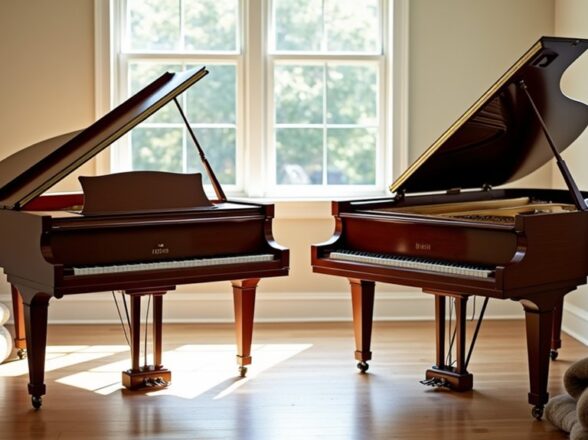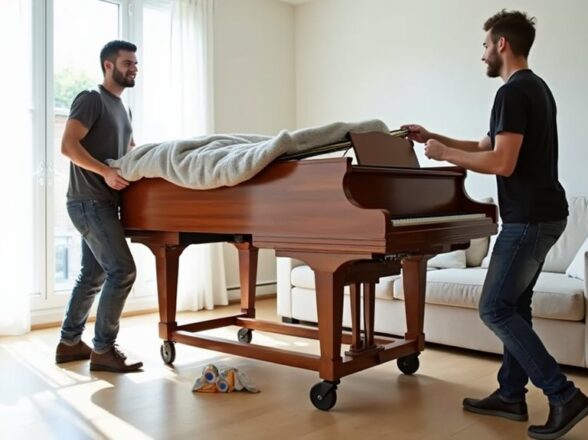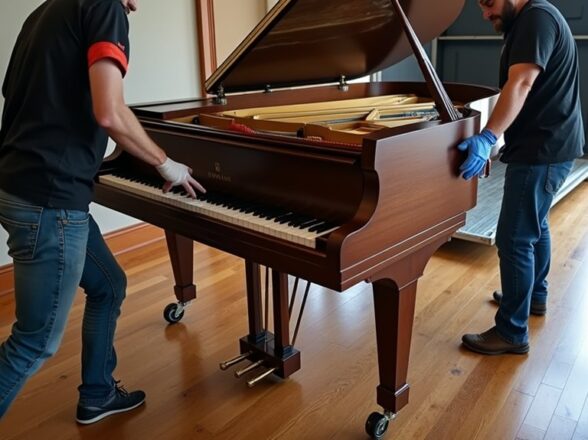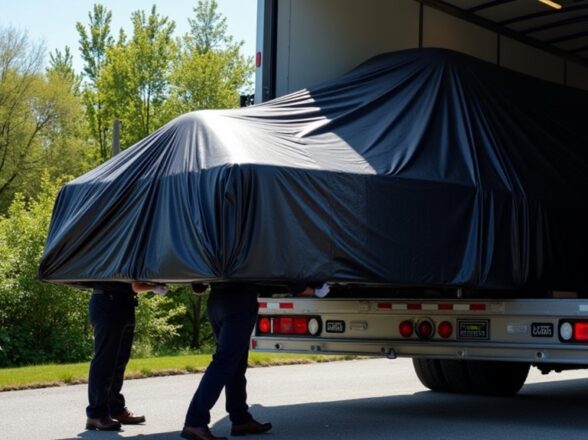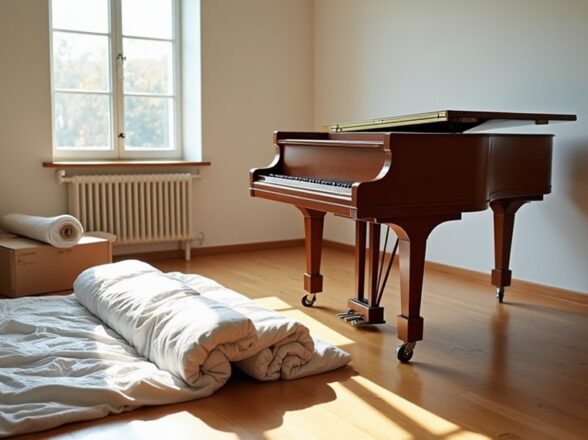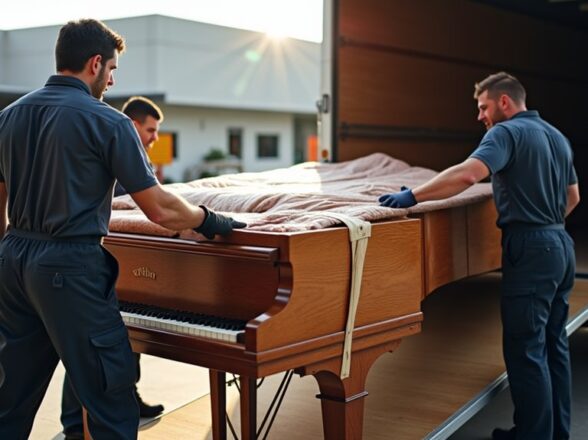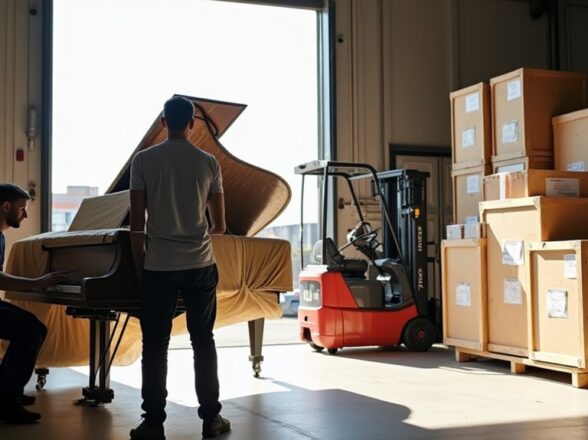How to Prepare Your Piano for Moving? A Pre-Move Checklist to Ensure Safety and Damage Prevention

To prepare your piano for moving, start by evaluating its condition. Check for any visible damage and document issues. Gather necessary materials like strong moving straps, a dolly, and protective padding. Wrap the piano securely with high-quality materials to prevent scratches and guarantee balanced weight distribution. If possible, enlist professional movers who specialize in delicate instruments for a safer experience. Finally, clean the piano, remove any detachable parts, and double-check that you have all required moving equipment ready. Following these steps helps safeguard your piano during the move, and there's more valuable guidance ahead.
Key Takeaways
- Conduct a thorough damage assessment to identify any existing issues before moving your piano.
- Gather essential moving supplies, including a dolly, strong straps, and protective padding for the piano.
- Secure the piano with high-quality padding and ensure balanced weight distribution during transport.
- Consider hiring professional movers to handle the piano safely and navigate challenging spaces.
- Perform a final cleaning and remove detachable parts, securing them separately for protection before moving.
Assess Your Piano's Condition

Before you start the moving process, take a close look at your piano's condition. This damage assessment is essential for ensuring its safety during transport. Check for any visible scratches, dents, or cracks on the exterior. Open the lid to inspect the strings and hammers for any signs of wear or damage. If you're unsure about the piano's condition, consider consulting a professional for a thorough evaluation. Follow some piano maintenance tips, like tuning the instrument before moving and keeping it clean. Document any issues you find, as this will help you address them later. Taking these steps now will save you time and potential costs after the move, ensuring your piano arrives in the best condition possible.
Gather Necessary Materials
Once you've assessed your piano's condition, it's time to gather the materials you'll need for the move. Start with essential piano moving supplies, including a sturdy dolly or piano cart for transport. You'll also need strong moving straps to secure the piano during lifting and moving. Don't forget about protective padding; this is vital for preventing scratches and dents. Blankets or moving pads can be ideal for wrapping the piano securely. If possible, use bubble wrap for extra cushioning, especially around delicate areas. Finally, grab tools like a screwdriver or wrench, in case you need to disassemble any parts. Having all these materials ready will help guarantee a smoother and safer moving process. Consider hiring a specialized piano moving service to ensure the best protection and handling of your instrument.
Secure the Piano Properly

As you prepare to move your piano, securing it properly is essential to prevent any damage during transport. Start by wrapping the piano in high-quality piano padding. This padding protects the surface and absorbs shocks. After wrapping, secure the padding with straps or tape to keep it in place. Next, focus on weight distribution. Make certain the piano is balanced, as uneven weight can cause it to tip or shift during the move. If using a dolly, make sure it's rated for the piano's weight and that the piano is secured to it with straps. Finally, always lift the piano using proper techniques, keeping your back straight and using your legs to avoid injury. This will help guarantee a smooth moving process. Additionally, consider using specialized transportation services that are equipped to move pianos safely and efficiently, reducing the risk of damage during transit.
Enlist Professional Help
When you're moving a piano, enlisting professional help can make all the difference in ensuring a safe and efficient process. Piano movers have the expertise and equipment needed to handle this delicate instrument. They know how to navigate stairs, doorways, and tight spaces without damaging the piano or your home. Additionally, hiring professionals can save you time and reduce the risk of injury. It's also wise to evaluate moving insurance during this process. Insurance can protect your investment in case of any unforeseen accidents. When you hire piano movers, ask about their insurance options to gain peace of mind. Trusting professionals not only safeguards your piano but also simplifies the moving experience overall. Consider hiring movers who offer expert packing services to ensure your piano and other belongings are handled with the utmost care during the move.
Final Preparations Before Moving

Before the big day arrives, you'll want to take a few essential steps to assure your piano is ready for the move. Start with a final cleaning to remove dust and debris from the surface. Use a soft, dry cloth to wipe down the keys and body, making sure it looks its best. Next, focus on instrument protection. Remove any detachable parts, like sheet music holders, and secure them separately. Wrap the piano with moving blankets or bubble wrap, paying extra attention to vulnerable areas like corners and pedals. Finally, double-check that you've arranged for the right moving equipment, such as a dolly or straps. These preparations will help assure your piano arrives at its new home safely and in excellent condition. Consider utilizing expert packing services to ensure that every aspect of the move is handled with the utmost care and professionalism.
Frequently Asked Questions
How Much Does It Typically Cost to Move a Piano?
Piano moving expenses typically range from $100 to $1,000, depending on distance and type. Don't forget to take into account piano relocation insurance to cover any potential damage during transport, ensuring your investment stays protected.
Can I Move a Piano by Myself?
You shouldn't move a piano by yourself. Proper piano moving techniques require multiple people for safety. Without help, you risk injury and damage. Prioritize safety and consider hiring professionals for safe piano transportation.
What Type of Piano Is Easiest to Move?
If you've ever seen someone effortlessly lift a digital piano, you know it's lighter than an upright piano. Digital pianos are generally easier to move due to their compact size and portability.
How Long Does It Take to Prepare a Piano for Moving?
It usually takes a few hours to prepare your piano for moving. Follow piano preparation tips and gather moving day essentials like blankets and straps to guarantee everything's secure and safe for transport.
Will Moving a Piano Affect Its Tuning?
Imagine a bird in flight, its song slightly off-key. When you move your piano, it often needs tuning adjustments. After the move, prioritize post-move care to restore its harmonious melody and prevent lasting discord.
Conclusion
Preparing your piano for moving is essential for its safety. Think of it like packing fragile glassware; a little extra care prevents big problems later. By evaluating its condition, gathering materials, and securing it properly, you can minimize the risk of damage. If you're unsure, enlisting professional help can save you time and stress. By following these steps, you guarantee that your piano arrives at its new home in perfect condition, ready for you to play again.
Related posts
Recent posts
Post Categories
Tags
Subscribe





